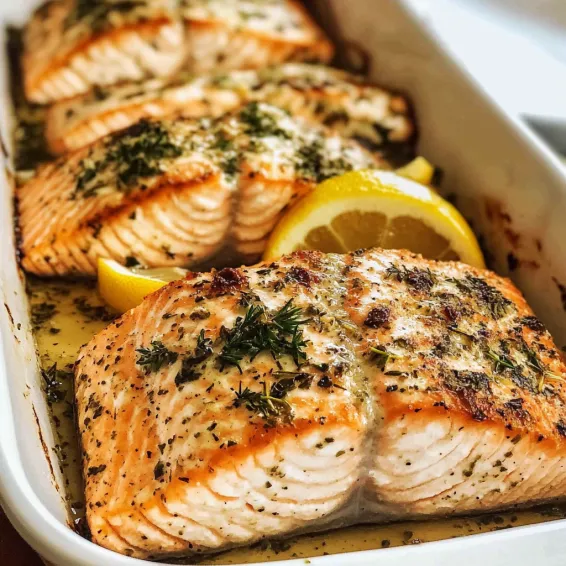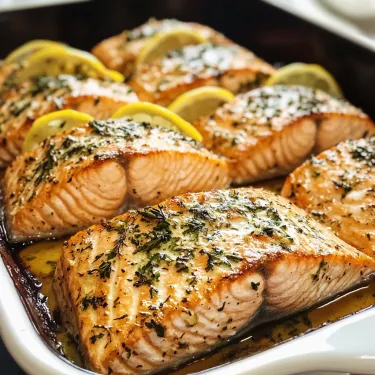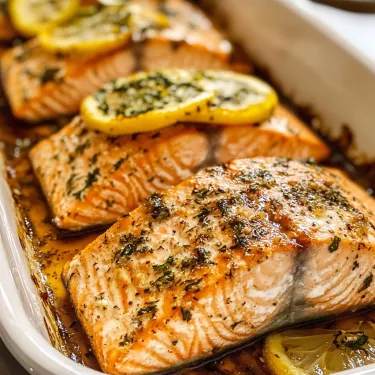 Save
Save
This incredible one-pan Easy Baked Salmon can be on your table in under 20 minutes. The simplicity of this delicious fish, infused with the flavor of tarragon, creates an irresistible dinner option that's perfect for busy weeknights or elegant enough for weekend entertaining.
I discovered this recipe during a particularly hectic week when I needed something nutritious yet quick. What started as a simple solution has become our family's go-to dinner at least twice a month, especially when fresh salmon is on sale at our local market.
Ingredients
- Salmon fillets: about 6 ounces each they provide heart-healthy omega-3 fatty acids look for bright flesh with a fresh ocean scent
- Salt: enhances the natural flavors of the salmon use sea salt or kosher salt for best results
- Black pepper: adds subtle heat and complexity freshly ground gives the best flavor
- Olive oil: creates moisture and helps the salmon cook evenly choose extra virgin for more flavor
- Fresh lemon juice: brightens the entire dish and cuts through the richness of the salmon
- Dried tarragon: the secret ingredient that transforms this from basic to exceptional with its subtle anise flavor
Step-by-Step Instructions
- Preheat and Prepare:
- Turn your oven to 400°F and prepare your baking sheet with a light coating of cooking spray. This temperature is perfect for salmon as it cooks it quickly without drying it out. Position your oven rack in the middle position for even heat distribution.
- Season the Salmon:
- Place your salmon fillets on the prepared baking sheet with a bit of space between each piece. Season generously with salt and pepper on both sides. The seasoning will help enhance the natural flavors of the fish and create a delicious crust.
- Create the Flavor Mixture:
- In a small bowl combine olive oil lemon juice and dried tarragon thoroughly. This mixture is what transforms ordinary salmon into something special. The oil helps the fish stay moist while the lemon and tarragon infuse it with bright refreshing flavor.
- Brush and Coat:
- Using a pastry brush coat each salmon fillet generously with the olive oil mixture. Be sure to get the sides and if the skin is off the bottom too. This ensures every bite has that wonderful tarragon lemon flavor and prevents the fish from drying out.
- Bake to Perfection:
- Transfer the baking sheet to your preheated oven and bake for 12 to 15 minutes. The salmon is done when it flakes easily with a fork and turns opaque. For a golden finish you can broil for the final 1 to 2 minutes but watch carefully to prevent burning.
 Save
Save
Tarragon is truly the unsung hero in this recipe. I discovered its magic after experimenting with different herbs and found nothing matches its subtle licorice notes against the richness of salmon. My daughter who typically avoids fish altogether asks for seconds when I make this version.
Perfect Pairings
This salmon pairs beautifully with simple sides that complement without overpowering. Try serving with steamed asparagus and lemon wedges for a light meal or alongside roasted garlic mashed potatoes for something more substantial. The versatility of this dish means it works well with nearly any vegetable side or grain.
For a complete dinner party menu consider starting with a light cucumber salad followed by this salmon with roasted seasonal vegetables and finishing with a citrus sorbet for dessert. The balanced flavors create a meal that feels special without requiring hours in the kitchen.
Storage and Leftovers
Properly stored leftover salmon can be remarkably versatile. Place cooled salmon in an airtight container and refrigerate for up to three days. For best results when reheating use a low oven temperature around 275°F covered with foil and just until warmed through to prevent drying out.
Leftover salmon also makes incredible salmon cakes or can be flaked over a salad for lunch the next day. I often deliberately make extra just to have these delicious options available for quick meals later in the week.
Choosing Quality Salmon
The quality of your salmon makes all the difference in this simple recipe. Look for fillets with bright firm flesh a mild ocean scent and no brown spots. Wild caught salmon typically offers superior flavor but good quality farm raised works well too.
If possible buy salmon the day you plan to cook it. When that's not an option store it in the coldest part of your refrigerator wrapped tightly and use within 24 hours for best results.
 Save
Save
Common Recipe Questions
- → How do I know when the salmon is perfectly cooked?
The salmon is done when it reaches an internal temperature of 145°F when measured with an instant-read thermometer. Visually, the flesh should be opaque and flake easily when tested with a fork. For the most accurate results, insert the thermometer into the thickest part of the fillet.
- → Should I remove the skin from the salmon before baking?
No, it's better to leave the skin on during baking. The skin helps prevent the salmon from sticking to the pan and protects it from overcooking. You can easily separate the cooked fish from the skin while serving.
- → Can I use fresh tarragon instead of dried?
Yes, you can substitute fresh tarragon for dried. Since fresh herbs are less concentrated than dried, use about three times the amount—approximately 1 tablespoon of finely chopped fresh tarragon instead of 1 teaspoon dried.
- → How can I store leftover salmon?
Store cooled leftover salmon in a shallow airtight container in the refrigerator for 2-3 days. For longer storage, wrap it tightly and freeze for up to 1 month. Thaw overnight in the refrigerator before reheating gently to prevent drying out.
- → What sides pair well with this salmon?
This salmon pairs beautifully with roasted vegetables like asparagus or broccoli, a simple green salad, steamed rice, or quinoa. For a complete meal that maintains the quick cooking time, consider preparing simple side dishes that can cook simultaneously with the salmon.
- → How do I remove pin bones from salmon fillets?
To remove pin bones, run your fingers gently over the flesh of the salmon to locate them. Once found, use clean tweezers or fish pliers to grasp each bone at its base and pull it out in the direction it's pointing. Taking this extra time ensures a more enjoyable eating experience.
